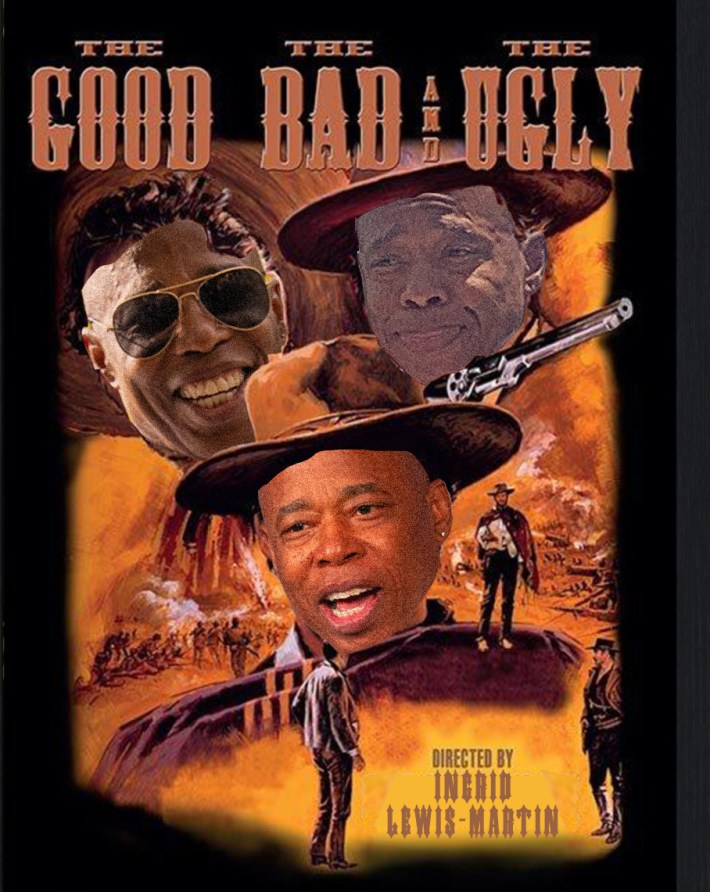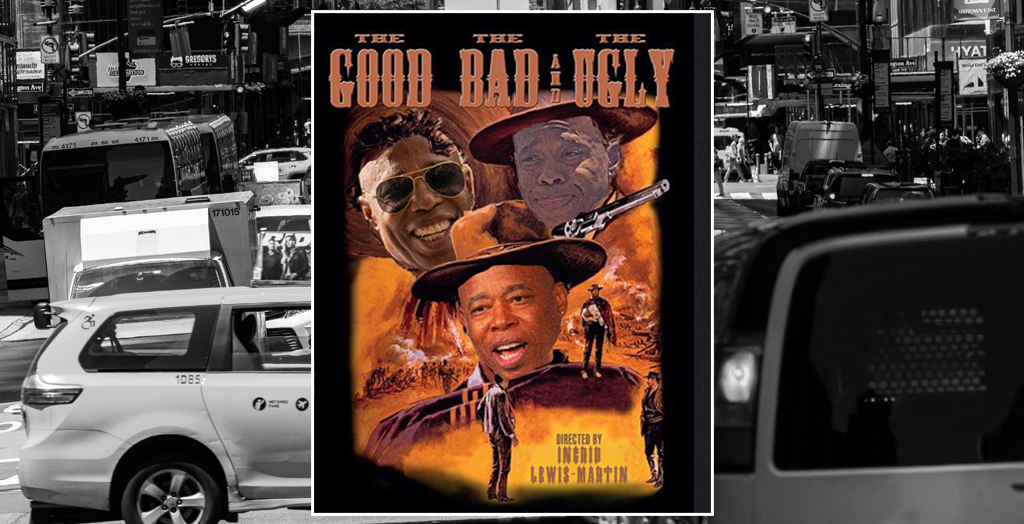We don't know at this point if Mayor Adams will leave office, be dragged out of it, or simply fade away from it after the end of a single term, but Thursday's federal corruption indictment offers a chance to take stock of Hizzoner's largely awful record on issues important to the livable streets community.
The mayor, who once compared Department of Transportation employees to drowning rats (but in a good way!), is facing growing calls to resign as the feds are circling the wagons around Gracie Mansion.
So, yes, it's time to look at the full legacy of Mayor Eric Adams in the following feature: "The Adams Record: The Good, the Bad and the Ugly."

The good
Adams finally took on New York City's age-old dirty habit of dumping trash on the sidewalk, tasking his Department of Sanitation to come up with a plan to box up garbage in containers. The most exciting component, European-style on-street containers, is set to debut in West Harlem next year. (Caveat: Other cities have been doing this for decades.)
Amid a housing crisis, Adams unveiled an ambitious City of Yes zoning initiative that would jumpstart new housing construction by getting rid of parking mandates. And Department of City Planning Director Dan Garodnick said this week that he's going to see it through, whether the mayor is named Adams or something else.
"I am totally committed to it and making sure that we give it the resources that we need to be able to get it over the finish line," he told Streetsblog.
Adams also committed to banning parking at 1,000 intersections a year, implementing a street safety design for better visibility known as daylighting. If his Department of Transportation does indeed follow through, that would mark a 10-fold increase over a Council law requiring the city to clear car storage at 100 crossings annually. (Caveat: He's only doing it because the city has exempted itself from a state law requiring daylighting at every corner.)
The bad
Like many politicians before him, Adams made many promises on the campaign trail and then forgot about virtually all of them once in office. As the father of his future rival often said, "You campaign in poetry and you govern in prose."
The poetry included pledges that got livable streets advocates excited: creating bike superhighways, subsidizing bike share, and taking one-quarter of the streetscape from cars and giving it back to people. Usually two out of three ain't bad, but in this case, a tiny portion of one out of three is.
Adams repeatedly failed to meet the annual requirements to add dozens of new miles protected bus and bike lanes under the 2019 Streets Master Plan, despite vowing to exceed those benchmarks while campaigning in 2021.
Remember, this is the guy who called himself the Bus Mayor and claimed he's done "an amazing job" for bus riders — and then proposed a mere seven miles of bus lanes in 2024. Long before he was indicted by the feds, Council Speaker Adrienne Adams said she'd consider suing the administration over this abject failure.
The law also requires Mayor Adams to build 50 miles of protected bike lanes each year.https://t.co/4y9dA1Nyho
— Transportation Alternatives (@TransAlt) September 26, 2024
The Adams dogma became clear when he gave a weird, rat-laced pep talk at DOT headquarters, telling 200 transportation officials that his legacy would not be how many miles of safe street infrastructure he created, but vague notions of community input and that New Yorkers felt "heard." (Never mind that the main knock on the DOT is that it has become stagnant in the face of tens of thousands of road injuries every year because it does too much community outreach.)
Meanwhile, as the Vision Zero era enters its second decade, the Adams administration is still overseeing worrisome trends in traffic deaths — especially for pedestrians this year.
Adams also helped facilitate the decline in outdoor dining by getting on board with the Council's legislation to replace the pandemic-era program that barred year-round streeteries. The once-booming effort to reclaim a tiny fraction of free car storage for outdoor seating came crashing down soon with just 2,592 restaurants participating after an Aug. 3 city deadline, compared to a one-time high of 12,502 as of two years earlier.
His DOT forged ahead with a plan to sink billions into rebuilding the Moses-era Brooklyn-Queens Expressway to last another century, after a push by the Brooklyn Democratic machine and despite opposition from the pols actually representing neighborhoods along the highway.
Probably to no one's surprise, Adams did nothing to tackle the scourge of placard abuse that pervades city, state, and federal government. Instead, Lower Manhattan looks more and more like Adams's Brooklyn Borough Hall, filled with vehicles with agency permits in their dash.
The ugly
The manner in which Adams runs his City Hall agencies was not cited in the corruption indictment unsealed by federal prosecutors on Thursday, but there is a connection: fealty to well-heeled political contributors masquerading as "community" voices.
As a result, Adams sabotaged street safety projects on behalf of major donors — and he did it by allowing chief adviser Ingrid Lewis-Martin to set up a rogue chain of command to intervene in bike and bus lane projects at the behest of the business interests and the donor class — and throwing the DOT under the bus repeatedly.
Examples include watering down the McGuinness Boulevard road diet, halting the Underhill Avenue bike boulevard, backpedaling on the Fordham Road busway, and trimming the Ashland Place protected bike lanes.
The mayor repeatedly showed his loose grasp on how to achieve street safety by calling crashes "accidents," and blaming pedestrian victims for their own deaths.
He also tried to cast bus lanes as a form of gentrification, ignoring the overwhelmingly working class demographic that relies on them.
Lest we forget, the mayor suggested there should be racetracks, at Floyd Bennett Field for example, for people who like to drive recklessly, so that if they "want to drive fast, there's an organized place."
Fortunately, that fast track went on a fast track to nowhere.
Correction: A previous version of this story stated that there was a 90 percent drop in outdoor dining applications. The number after the city's Aug. 3 deadline for existing participants counted 2,592 restaurants, down from 12,502 as of July 2022, according to an NYU report, which marks a 79 percent decrease.






